|
|
Post by brutalis on Mar 14, 2019 13:25:59 GMT -5
Never picked up any Strazynski Squadron Supreme stuff. By this point it is like beating a dead horse as the JLA has changed so much as well as the SS. So much to the point there is nothing worth saying or doing with the SS that DC may not have already done with the JLA. The initial draw in the whole concept was to seeing what the JLA could be like in a Marvel comic. That idea has long since passed being interesting.
|
|
|
|
Post by rberman on Mar 14, 2019 14:20:33 GMT -5
Never picked up any Straczynski Squadron Supreme stuff. By this point it is like beating a dead horse as the JLA has changed so much as well as the SS. So much to the point there is nothing worth saying or doing with the SS that DC may not have already done with the JLA. The initial draw in the whole concept was to seeing what the JLA could be like in a Marvel comic. That idea has long since passed being interesting. There are always more good stories to be told, and SS don't have to be "JLA in a Marvel Comic" just because that was the original concept. |
|
|
|
Post by brutalis on Mar 14, 2019 15:48:49 GMT -5
Never picked up any Straczynski Squadron Supreme stuff. By this point it is like beating a dead horse as the JLA has changed so much as well as the SS. So much to the point there is nothing worth saying or doing with the SS that DC may not have already done with the JLA. The initial draw in the whole concept was to seeing what the JLA could be like in a Marvel comic. That idea has long since passed being interesting. There are always more good stories to be told, and SS don't have to be "JLA in a Marvel Comic" just because that was the original concept. True enough about good stories to be told but as I flipped through the early Straczynski SS, it did nothing for me and I let it go on by. |
|
|
|
Post by codystarbuck on Mar 14, 2019 16:13:55 GMT -5
Well, on that note, let's segway into JMS....... Supreme Power #1 Scary little bugger, isn't he? Creative Team: J Michael Straczynski (from here on known as JMS)-writer, Gary Frank-pencils, Jon Sibal-inks, Chris Eliopoulos-letters, Soto-colors, Mike Raicht-edits, Joe Quesada-story editor and chief. Bill Jemas-sticking his nose into the credits. That's about as bad as Hollywood, where the person who wipes the star's backside gets credited as special assistant, or something. Synopsis: We open with juxtaposed images: a spaceship flies through the spaceways, singing and a couple are driving on a country road, in a pick-up truck, listening to Nick Lowe... A fiery ball careens across the sky and crashes in a nearby field. The young couple pull over and go investigate, finding some kind of metal container. with a child inside. The woman says he is sent from Heaven. The man looks at the metal vessel and the pool of green fluid inside.... 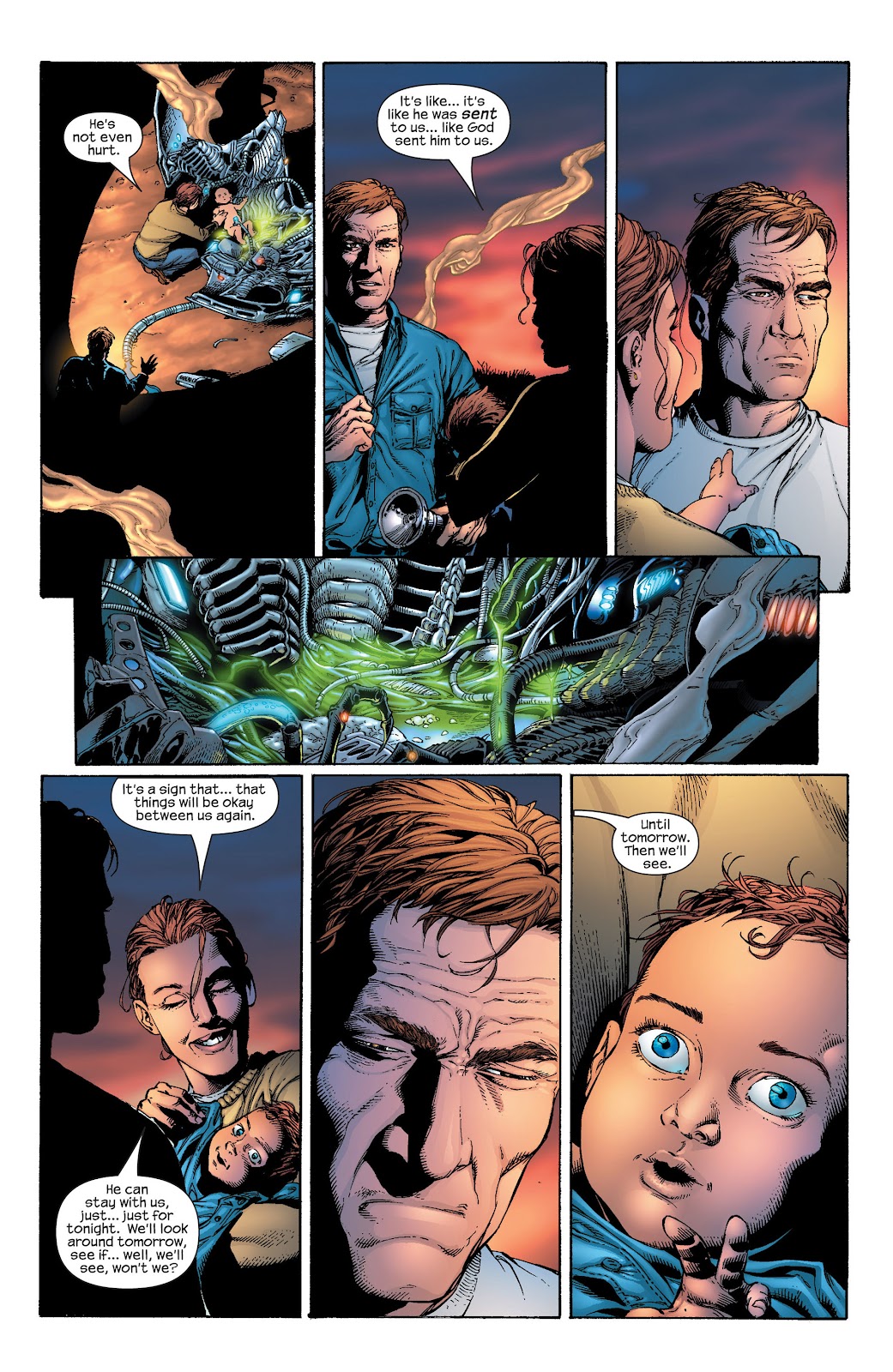 Uh, yeah....Heaven. They take the child back to their farmhouse, just missing the squadron of helicopters that descend upon the scene. We cut to the house, as the woman plays with the infant, just as men dressed in black fatigues, gas masks and balaclavas come in the door, laser sights swirling about the room. The child is next seen, sitting on a conference table, as US President Jimmy Carter is briefed as to his probable origin, extreme density of his skin and strength of his hands, the metallurgical analysis of the pod, and that the child's DNA doesn't match the human species or any other terrestrial pattern. We are told that the couple has been warned to keep quiet and President Carter says the child is an orphan and a ward of the state and should be raised as an American, in a rather cryptic fashion. We next see a couple briefed as to their mission: they are to act as parents to the child, forsaking all outside relationships, while also not becoming intimate within the home environment, as it would create emotional stresses that might trigger responses in the child. In other words, they are to be mom and dad, in a 50s tv show. They are introduced to the child, named Mark Milton, which has been tested with focus groups. The project is code-named Hyperion. We see the couple celebrating the child's birthday, in a Norman Rockwell home setting, hidden in a grove, behind hurricane fencing and razorwire, with armed guards and signs that say "F-off or die!" (in slightly less direct verbiage). Everything is monitored remotely, as we see the child presented with a puppy and left alone with him. 47 animals were screened before they chose this particular breed and named him Spot. The puppy senses something different about Mark and barks at him, upsetting the toddler, unleashing horrifying consequences... 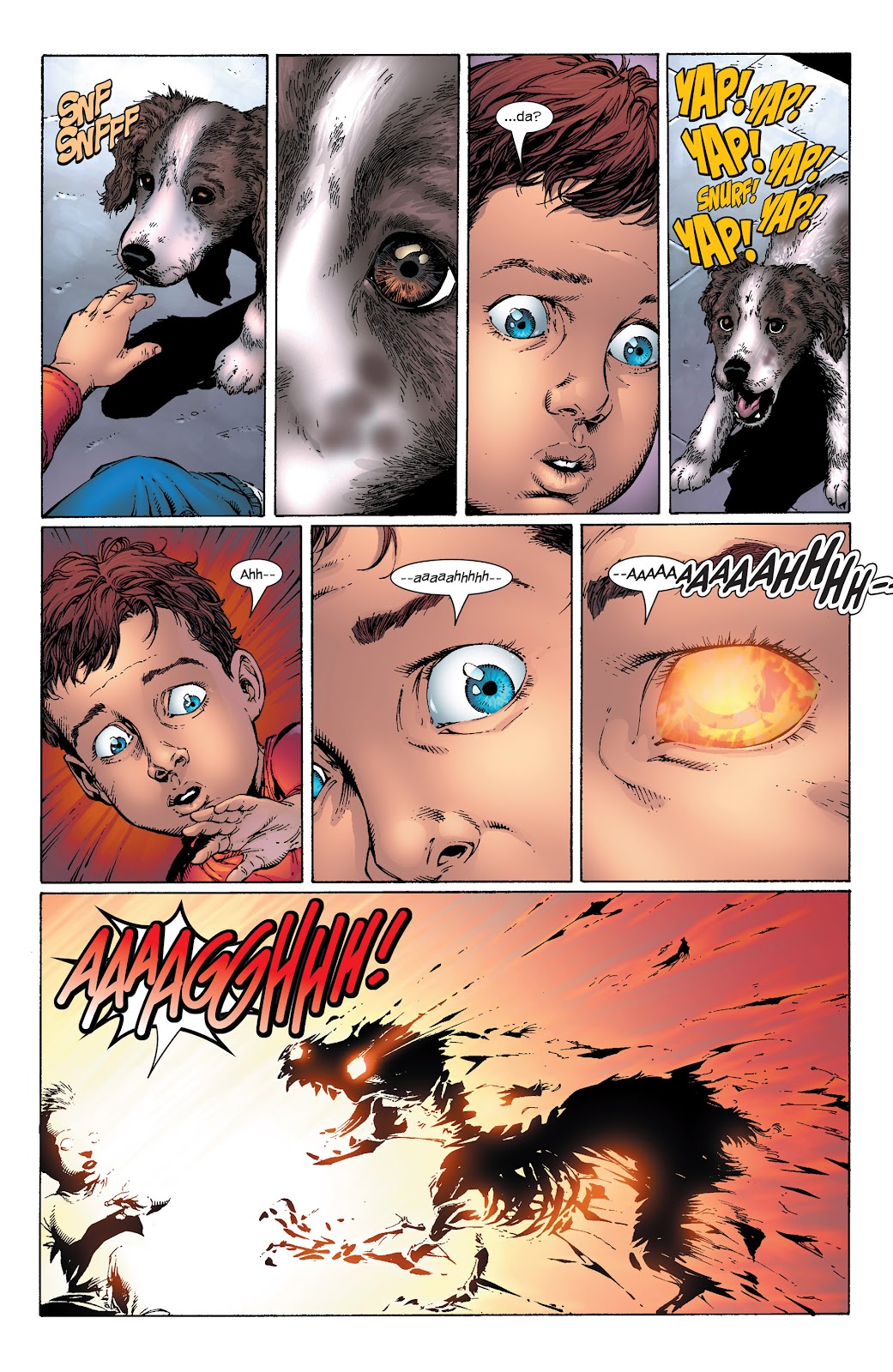 Afterwards, the "parents" are skittish around the child. They make sure he is calm, but are on edge. They meet in a closet, away from the cameras, to "feel alive." What follows are scenes of Mark at different ages, listening to news stories of major events, juxtaposed with his education and indoctrination, with fairy tales that have anti-communist messages, and lessons of good citizenship and American Exceptionalism. Eventually, President George HW Bush is briefed on the program. The scientists are trying to reverse-engineer the technology; but, it is so advanced, possibly organic, that they have made little progress, in the past 13 years. He is shown a crystal, which refracts light, like a prism, and is told that it was the power source, though they don't really know how it works, other than it can sense neural patterns, when touched, and turn thoughts into realities. it has been isolated to prevent accidents from a random thought. Pres. Bush says they need to be more disciplined, and suddenly sees an attractive female lab worker suddenly appear in a corset and stockings, holding a riding crop and a dog collar & chain. When he suddenly stands up, he sees the woman as she was dressed, in a lab coat, sweater and plaid skirt. he makes a remark about getting one of those crystals for Barbara as he is taken to be shown some restored images from space. We see some kind of attack on the vessel. There is footage of the child being put in the pod, which ejects and heads on a trajectory for Earth. Pres. Bush recognizes that the footage was transmitted to the pod, since it was external and that the ship was large and probably not on a joy ride. They are wary of why the ship was in the area and who attacked it. Meanwhile, a teenaged Mark is sitting outside and tells his father that he can see every molecule in every blade of grass, and can also see the hidden guards and fencing. His father says it is to keep others from being hurt, by accident. Mark asks if his parents love one another, because that is the only reason he will stay inside the fence and demonstrates why the fence isn't much of a barrier... 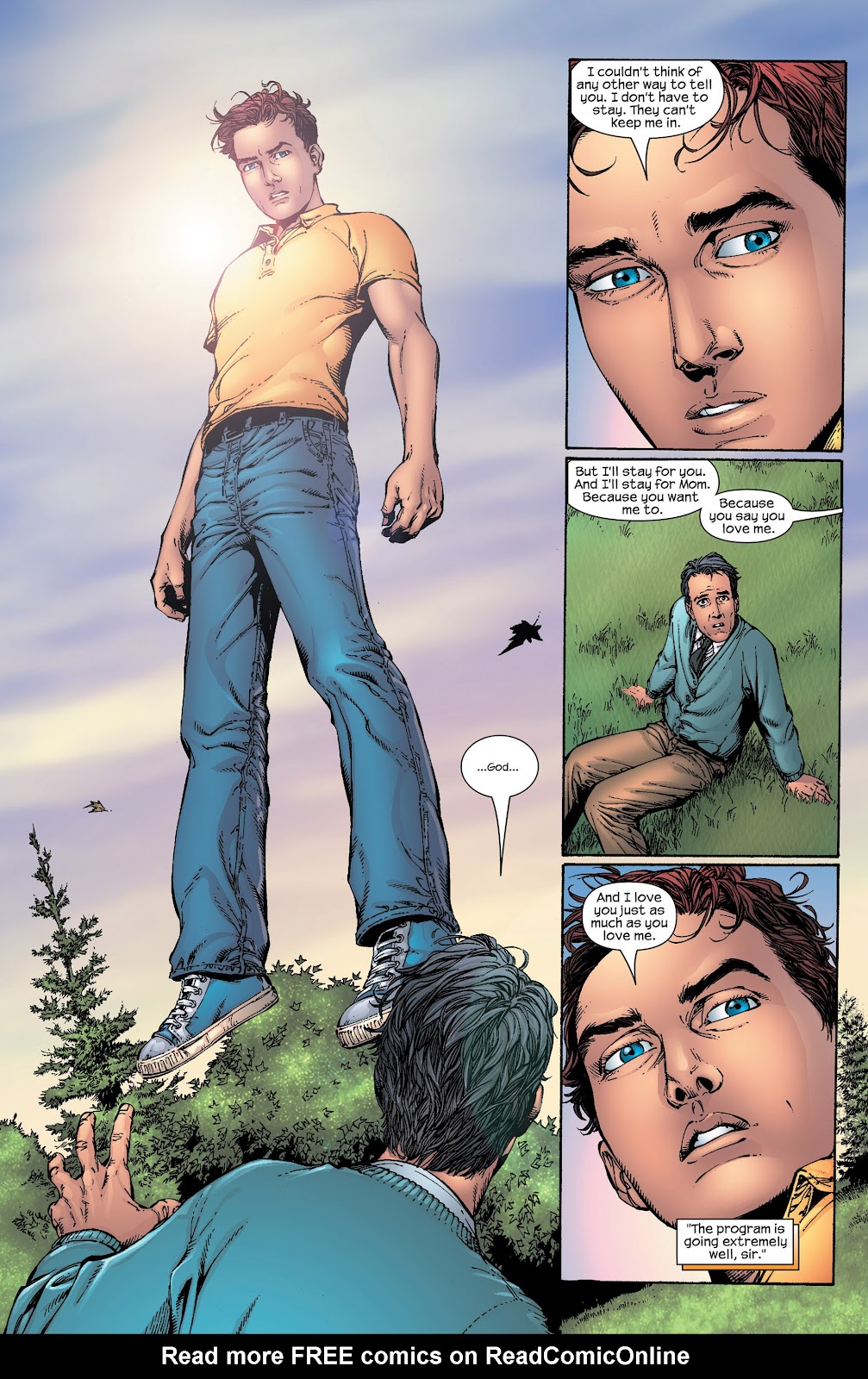 He makes cryptic statements about loving his parents as much as they love him. We cut to Pres. Bush, who still wonders how successful the project is, despite the assurances of his advisors. We end with two African-American women, talking about one's young son, who has been quiet and solitary of late. When he was young, he was taken violently ill and barely survived. since then, he has been different. We see the young man playing with his dog, then racing as fast as he can, creating a sonic boom. Thoughts: Lot of exposition and introduction here.Joe Straczynski is and was a Hollywood writer, who worked as a writer and story editor on such shows as Murder She Wrote and Captain Power & the Soldiers of the Future. he was also creator, primary writer and producer of the 5 year novelistic tv series, Babylon 5. He had been writing some comics, in between tv and movie gigs, including his own series, Rising Stars, done for Marc Silvestri's Top Cow. In that series, a cosmic event affected a group of children, who were in utero, and displayed fantastic abilities, after birth. They are located and segregated and raised inside a government compound, where things like sexual abuse affect their psychological growth. When one dies, their power is passed on to the others and someone has been murdering the subjects, one by one. The series sought to follow in the footsteps of deconstructionist superhero comics, like Watchmen and Squadron Supreme, applying more real world science and logic to the stories. JMS is doing the same, here. Mark Milton is an alien. His arrival on Earth is a parallel to Kal-El, the future Superman. he is found by alternate Kents, but is taken away by the government, who tracked the spacecraft landing, thanks to the NORAD early warning system. He is then raised under government supervision, in an artificial and controlled environment, where he is conditioned to think and act as the model American; at least, from a more conservative point of view, as we see in some of his schooling. We also see hints of his alien brethren and their technology, including this prism, which reacts to thoughts and can create realities from them. There are tongue-in-cheek moments, such as a visual shot, on page one, of the ersatz Jonathan Kent, digging in his ear canal, as well as conversation from the techs monitoring Mark and his "parents," as they compare them to the new movie, The Stepford Wives, and one jokes about the name Spot, after the animal has been flash-fried and a blast image on the wall is all that remains. Then, there is the gag of the female tech, in domination attire, when Pres. Bush looks through the prism and thinks they need discipline. What is very central to this is a sinister undercurrent, relating to how dangerous Mark is, from the moment he is discovered, through his adolescence. Needles can't pierce his skin and his infant hands can crush. He is fed a bottle via a long handled clamp device. Much care is taken to keep him psychologically content and relaxed, less they trigger an anxiety response that could be deadly. We see how the indoctrination has taken hold and think about what a Superman could do, if he didn't limit himself. Especially, if his ideas of "Truth, Justice and the American Way" have a very xenophobic and dogmatic facet. Could he become an instrument of American conquest? Even more dangerous is his conversation with his father, as his comments suggest he is well aware of the facade erected around him and that people fear him and his abilities and then demonstrates there is more to fear than they know. He sends a subtle message that he will stay with them, as long as they reflect his love. What happens if he doesn't feel loved? We then end with the idea that something related to the pod coming to Earth may have affected others, as the young boy demonstrates supersonic speed. Did this alien vessel not only bring a Superman; but create the possibility of "super powers?" JMS demonstrates what a good writer he is, infusing the characters with life and quirks, even just through snippets of dialogue. His treatment of the two presidents, Carter and Bush Sr, seem a bit off, from their public personas, Carter more than Bush. Everything I have ever read of Carter doesn't suggest that he would direct the Hyperion project to be undertaken in the fashion is is. Now, perhaps the political indoctrination is a by-product of the Reagan Administration, which would soon follow. The Bush elements suggest someone who quickly analyzes things and comes up with key questions and theories. Bush was head of the CIA, where he would have been used to analysis and conclusions, though he was the director, not an analyst. He also ran an oil business and would probably ask a lot of big picture questions. At one point, a scientists compares the examination of the ship to an F-16 landing in the middle of an aborigine village, which upsets Bush, about the comparison of the American people to aborigines. The statement is open to interpretation, suggesting racism or a belief in the intellectual and cultural superiority of America. The latter does fit within the Neo-Con propaganda, which was taking hold in the Bush years, though Bush himself was not of the Neo-Con wing of the Republican Party. However, many of his advisors were in that sphere, including people like Cheney and Rumsfeld. Those same people would return for Bush Jr, with a very decidedly Neo-Con administration. JMS has always come across as a social liberal, though a bit middle of the road, in terms of foreign affairs and the like. He is definitely a political thinker, as politics were a major component of his B5 five year story arc. That is on display, here. Gary Frank's clean art style is part of that modern "widescreen" style, though his layouts are a bit more traditional than Bryan Hitch and some of the others. He built a rep on Peter David's Hulk series and he handles the "real world" approach well, as he is adept at period costuming and real world technologies, though his helicopter silhouettes appear to be Blackhawks, which were introduced in 1979, into the Army (after winning a competition, in 1976, for a replacement for the Huey). That does coincide with Nick Lowe's "Cruel to be Kind," being heard on the radio. The first news report we see is about Cambodia and the genocide of Pol Pot, as well as the Iranian Revolution; so, he seems a bit early for a whole squadron of Blackhawks and men in black tactical gear; but, this is a black ops program; so, it's possible. Given the gear that the failed Iran Rescue Delta Force team had, at the time, he is jumping the gun a bit. Minor details, though. This was done through Marvel's Max line, which allowed more adult content, resulting in the rather vile and vulgar Nick Fury mini, from Garth Ennis, which is rumored to have killed a proposed film, in which George Clooney had been interested in starring. JMS, having written to tv standards, for years, keeps it in pretty much PG-13 areas, with implied sex and the use of the S-word, though no F-bombs (which was allowed, as Ennis proved). I think JMS didn't feel it was necessary to go there, just because he could, which is a welcome change from a lot of people who write without those restrictions (looking at you Mr Tarantino!) The book is a fine package, with excellent writing and art, on quality paper, and it was promoted well. If only Mark Gruenwald could have had this kind of push and editorial backing; he might have tried a bit harder to make his series a bit more mature than it was. His was still very much in that Code-approved mindset, rather than the more unrestrained approach that Alan Moore used. JMS uses his freedom to give the thing detail and scope, while still keeping a tight focus. This is less about superheroes attacking real world problems than superheroes appearing in a more "real world" environment and how that causes change and conflict. In that, it has far more parallels to Watchmen than Squadron Supreme. There was a special edition of the first issue, which included developmental sketches of Hyperion and some of the other characters, and the thought process behind them, as well as a snippet of the intro of the Squadron Supreme, from Roy Thomas.  The original cover is quite creepy and sets the tone to the whole thing. Hyperion has a haunted look in his eyes, rather like a Damien Thorn. The child wrapped in the flag suggests the conditioning of him. You know this will be a dark story, regardless of the content warnings. In a lot of ways, this is just a continuation of Rising Stars; kind of a redrafting, if you like. The main plot is different, but, much of the story mechanics are the same; certainly the approach. Rising Stars ended up in an editorial dispute, as well as time commitment delays, putting it on hold for a bit, before it was finished. That would foreshadow problems with this series and JMS, at Marvel. One thing is for certain, this was put out as a Big Deal, by Marvel, who were doing a lot of recruiting of superstar writers, from other media, to work on their comics (Tamora Pierce, Laurel K Hamilton, Stephen King), which DC also dabbled in (Jodi Picoult, John Cleese, Kevin Smith, Brad Meltzer). Like Smith and Meltzer, JMS had strong comic connections and enjoyed working in the field. Some others had past loves, but mixed experiences with the material. Tamora Pierce swore off working with Marvel ever again, after editors were deaf to her criticism of the artist's approach to her story, about a female White Tiger. She had been a big fan of Don McGregor's work, and characters like Misty Knight and Colleen Wing. JMS had a few issues at Marvel, though seemed to settle them and come back for more work, as his Hollywood commitments allowed. So, this isn't Gruenwald's SS, nor is it entirely a JLA pastiche or analogue, apart from the characters involved. It isn't mirroring Grant Morrison's JLA, as he was still dealing with a superhero environment, even if he was applying different influences. This is more of a mix of an Alan Moore approach and a Mark Waid mindset, from someone who spent time crafting his own epic story. In many ways, it is probably closer to Moore's Miracleman than Watchmen. |
|
|
|
Post by rberman on Mar 15, 2019 0:26:04 GMT -5
Supreme Power #1
My Two Cents: The similarity of the set-up to Rising Stars is obvious. An apparent meteorite becomes the entry of super-ness into a mundane world, and the U.S. government races to control and leverage the situation, setting up a clash of titans. That one has a protagonist named “Poet” with the initials JS, one of JMS’ many authorial stand-ins. (See also John Sheridan, Jeffrey Sinclair, etc.) Supreme Power instead has a protagonist named Milton. Rising Stars ran from 1999 through 2003, then paused for almost two years while JMS hammered out a dispute with the publisher over film rights. (They tried to shut him out of writing the script.) By the time it returned for the final three of its planned twenty-four issues, this series was already well underway at Marvel, spinning off in a different direction despite the similar premise.  This series (like that one) also lies in the shadow of Watchmen, with realistically flawed heroes trying to make sense of their place in the world, and a superhero drama standing in for geopolitical concerns. But where Watchmen offered the threat of nuclear holocaust, this story deals with America’s willingness to interfere with other nations in pursuit of its own interests. Hyperion is the initial American secret weapon, but as we’ll see, that situation changes before long. As with Watchmen and Gruenwald’s Squadron Supreme, the cost of peace, and the moral compromises along the way, are very much in view.  Another series that overlapped substantially with this was Kurt Busiek’s Superman: Secret Identity (2004), an “imaginary tale” focusing on the American government’s attempt to detain, analyze, and co-opt Superman.  With the not insignificant talents of Kurt Busiek and Alan Moore working in the same conceptual space, what does our esteemed TV writer/producer bring to the table here? Well, the opening fake-out involving “Ma and Pa Kent” getting the rug from under their adoption by a tactical unit was cute.  I already talked about Mark Milton’s last name. JMS makes a point of reminding us that “Mark” is from the Bible, citing “Mark the Apostle.” Mark’s more common title was “Evangelist” since he authored one of the four “Evangels” or gospel accounts, though he can also be found in lists of “Apostles.” Mark’s gospel account is distinctive for focusing on Jesus as a man, and for emphasizing his actions over his teachings. Milton’s Truman Show-esque upbringing raises questions. Wouldn’t the government have found an actual married couple to pose as parents? They say it would be risky for them to be actually romantically involved, but surely it’s riskier still to throw a man and woman together to pretend to be a loving family around the clock for twenty years.  And then it’s surprising that they don’t grow into an actual couple (one panicked tryst in the closet notwithstanding) during that time. I guess the dad pretended to have a job to take him out of the house, but mom just stayed at home on child care duty. We do see him scraping the dog residue off the cabinetry, so apparently he knew better than to play “king of the castle.”  Speaking of which: The crisped dog was a nice deflation of all hopes that this situation could be contained, while the griping monitor room kibitzers made for some nice comic relief.  George Bush, former CIA chief, was depicted as not a moron for a change. He recognizes the implications of the found footage of the space battle, and later he will comment that keeping secrets from Mark Milton will prove nearly impossible. The brief scene of S&M fantasy seemed gratuitously thrown as the “explicit content” warned, nay promised by the large label on the cover. Did JMS add it because this first issue was otherwise too tame for the MAX label? JMS’ best move is his leisurely pace. There’s no hurry to introduce a super-team. Until the last two pages, we’re offered no evidence there are even plural supers to form a team. Eventually there will be plenty, but even then the story belongs to Mark Milton, with all the other characters defined primarily in relationship to him, just as Dan and Laurie form the emotional core of Watchmen.
|
|
|
|
Post by codystarbuck on Mar 15, 2019 1:57:57 GMT -5
I suspect the S&M fantasy is a jab at the rich and powerful Ivy League types and probably a similar mindset in Hollywood execs. It's certainly a satirical association (with much historical evidence to support it) with british politicians; and, especially, conservative politicians.
SNL and Dana Carvey aside, Bush Sr was generally considered an intelligent guy. he certainly came across that way when standing next to Dan Quayle. Then again, even W came off well compared to that guy. I think JMS has him keying in a vital questions rather quickly; but, I suspect that is more a story necessity than his view of the guy, much like Carter being so nationalistic about taking custody of baby Mark. Again, I think it is a story necessity and if he pushed it forward two years, and had it be Reagan who is initiating this, it would seem more within character.
The tech seems a bit more advanced than the timeframe; but, that is much a factor of Gary Frank's design choices, rather than a statement about the world. 1970s closed-circuit tv systems were analog and more primitive, as you can see in movies like Westworld. Frank's stuff looks a bit more digital. Same with the Men In Black helicopters and black tactical gear. It would have more likely been Hueys (or Sikorsky Green Giants) and and standard Army fatigues (which were still, mostly OD green. The look Frank shows is very much the SAS combat rig, as made famous in the 1980 Iranian Embassy Siege. That would eventually be adopted by Delta Force and SEAL Team 6, as they all cross-trained with the SAS (and the value of the gear was combat-proven). This being published in the mid 00s, it looked familiar and was what the general audience expected, thanks to Hollywood and comic cliches. That is a danger of doing a period story, though you can get away with it if you keep the period a bit generic and your audience is young enough not to know better.
When I compare this to Rising Stars, it is more in the approach, than the content. I also think the Miracleman comparison, vs Watchmen is more apt, as we have the real world logic to things, the appearance of a superbeing being related to otherworldly sources, and setting the government on edge, then changing everything when it goes public. Later, as we will see, there is a deliberate comparison to The Ultimates, before the crossover with the Ultimate line (not to mention a bit of counter-logic to Warren Ellis and Stormwatch).
One thing that JMS subliminally accomplishes is demonstrating what an influence Jonathan Kent (and Martha, to a less demonstrated extent) had on young Clark, in forging him into Superman. The fake father has the heart-to-heart talks; but, Mark detects the insincerity and the artificial nature of his environment. Clark's home environment is real and reflects the morals and values of the Kents, which shapes the hero he becomes. This is where Man of Steel failed miserably. Jonathan Kent might fear that someone would attempt to take Clark away, if his abilities became known; but, he could never counsel Clark not to use his abilities when people are in danger (particularly if they would die unless he did something). The best descriptions of this influence are in Eliott Maggin's two novels, especially the opening chapter of Miracle Monday. Glen Ford got it, John Schneider got it; Kevin Costner did not.
As we will see, Mark's influences come from other places, some a bit shocking.
|
|
zilch
Full Member
Posts: 244 
|
Post by zilch on Mar 15, 2019 21:49:33 GMT -5
Don't read too much into JMS's choice for Hype's secret id name... it came from Don and Maggie Thompson.
-z
|
|
|
|
Post by codystarbuck on Mar 15, 2019 23:14:31 GMT -5
Don't read too much into JMS's choice for Hype's secret id name... it came from Don and Maggie Thompson. -z In this work, though, the choice of it by the government comes from the Gospel of Mark, while Milton is used, because it sounds like Middle America: Milltown, Middleton, Milton. It is stated in dialogue, during a briefing. |
|
|
|
Post by codystarbuck on Mar 16, 2019 0:13:57 GMT -5
Supreme Power #2 Dr Spectrum is the focus of this issue, though Hyperion is also featured. Creative Team: JMS-writer, Gary Frank-pencils, John Sibal-inks, Chris Sotomayor-colors, Rus Wooten-letters, Mike Raicht and Nick Lowe (not the singer, I assume)-edits, Joe Quesada-Story Editor and EIC, Bill Jemas-President, Special Thanks to Andrew Lis. Joe Quesada's dog washed and groomed by Pampered Puppies Pavillion. Craft services by Skittles and Starbucks. All animal scenes monitored by the American Humane Society. All human scenes monitored by the American Kennel Club. Synopsis: Mark Milton is having a history lecture, about D-Day, when he decides to flash-fry the teacher's book. Dad takes him to the hills to have a father and son heart-to-heart.... 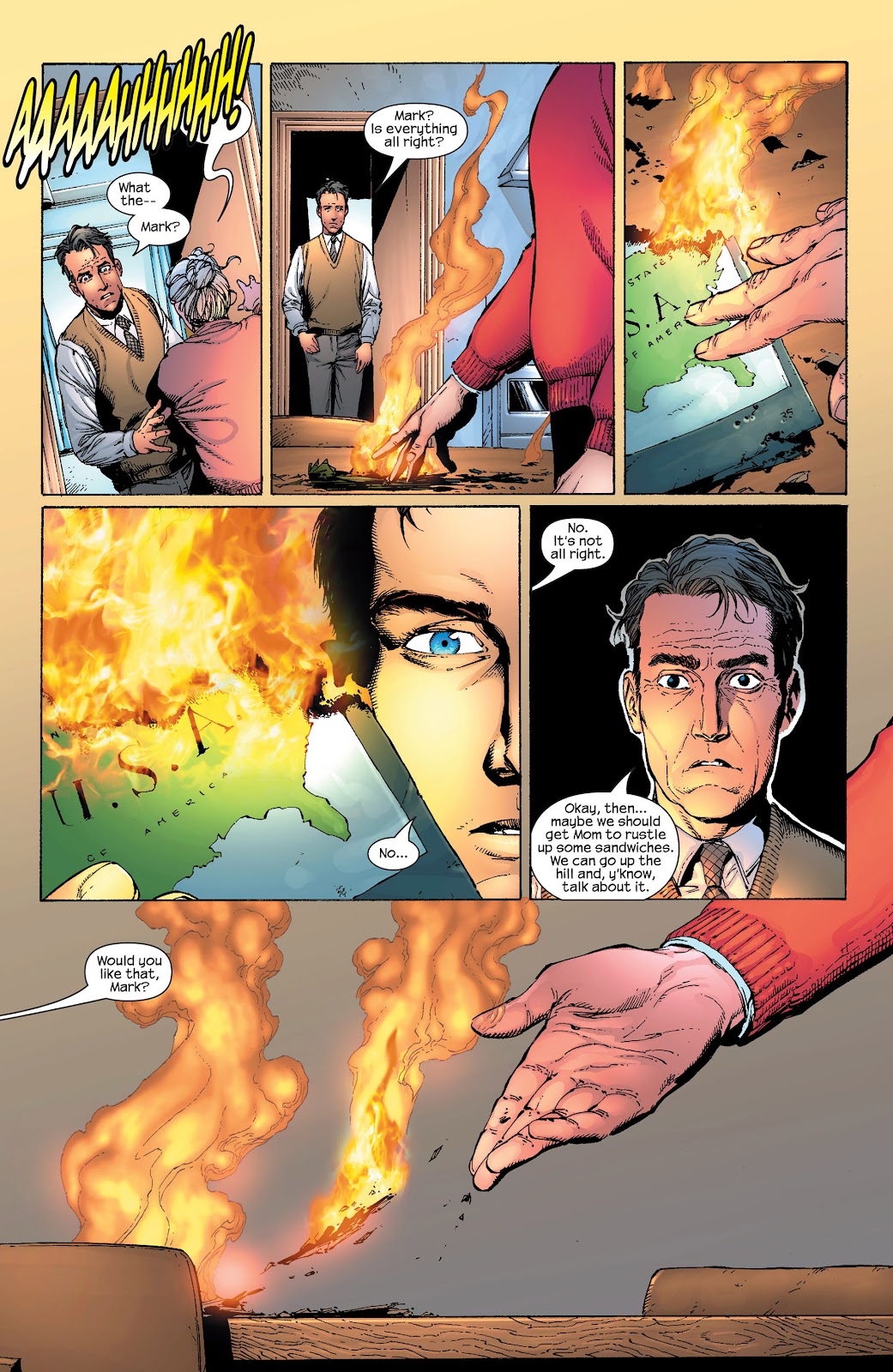 Mark wants to go to school outside the fences, with other kids. he can control his powers, so there is no threat to others, unless his father thinks he is dangerous. We cut to the project heads, who address the situation and it is decided that Mark will attend school with military brats, so that they can control the environment. The school bus comes to pick Mark up... 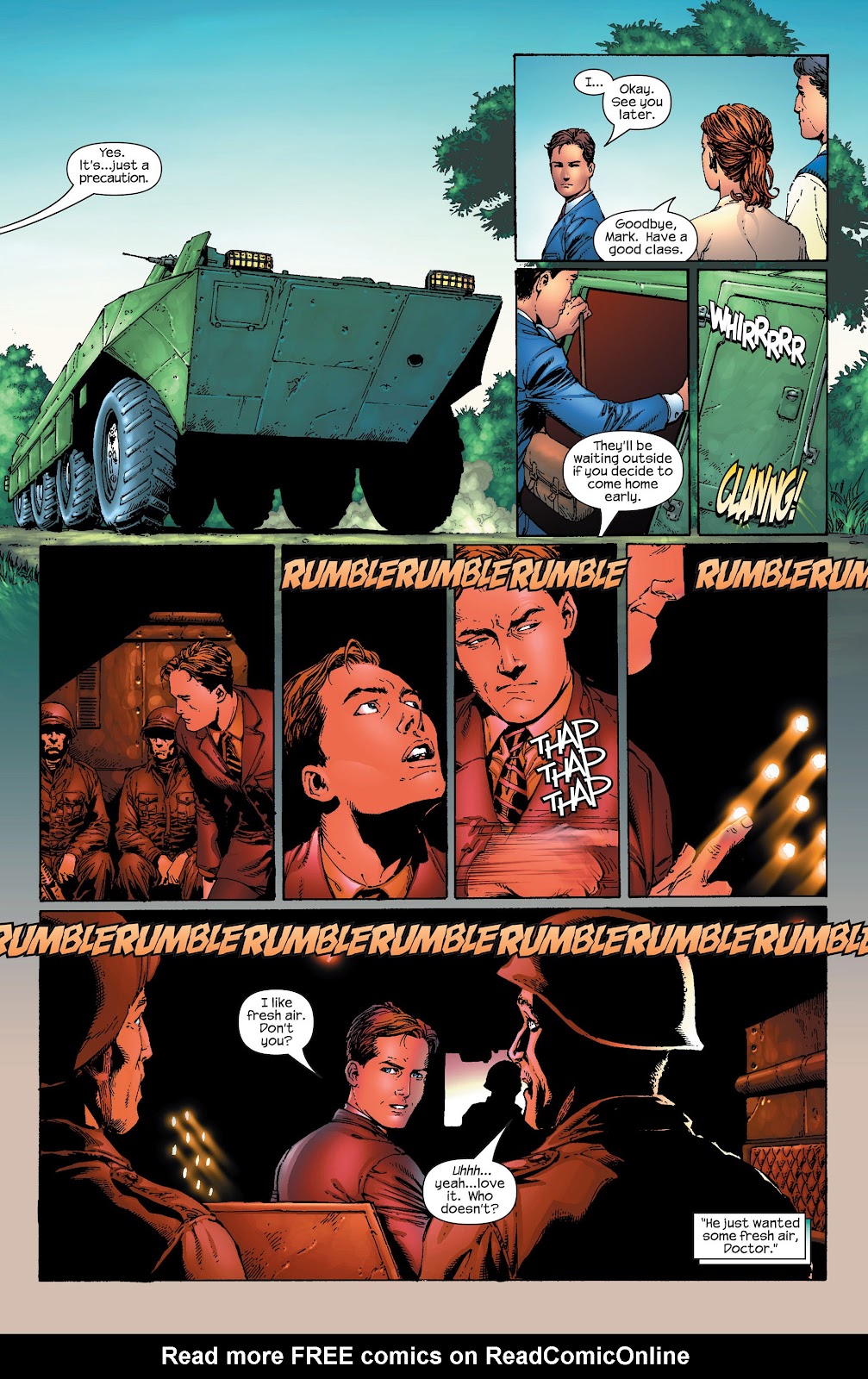 We cut to a hospital, where a doctor goes to talk to a man named Phil. We see flashbacks to the night that Hyperion's pod crashed to Earth and see flashes come off the ship, witnessed by Phil and his wife, Debbie, who is pregnant. On the way to the hospital, the car breaks down and their child is born in the car. It is not what they expected; both are horrified. Debbie walks into the ocean with it, commiting suicide, while murdering the infant. Except, the child can survive in the water. Phil is accused of murdering wife and child and has been locked up ever since. Next, we see an affluent African-American family leaving an evening church service. the father identifies a nighthawk, which is calling out in the night. he speaks of the hard work to build his business, that allowed the family to leave Memphis. They are flying to New York, in the morning, when they are accosted by racist thugs, with a shotgun. Husband and wife are gunned down, leaving the young man alone, as the nighthawk flies overhead. We then cut to an unnamed Guatemalan jungle, where Cpl Joe Ledger has been tracked down, to receive new orders to return to the US. As the helicopter pulls away, we see dead bodies strewn about and fires burning. the area has been pacified. Ledger is a black ops soldier, who is briefed about the Hyperion ship and the crystal. Ledger has been tapped to test it, as he is known for his focused work, like a surgeon. He tests it on a firing range, making energy blasts come from it, destroying targets,. the crystal heats up with use and he puts it on top of his hand to cool, and it starts bonding with his skin, becoming a permanent part of him. 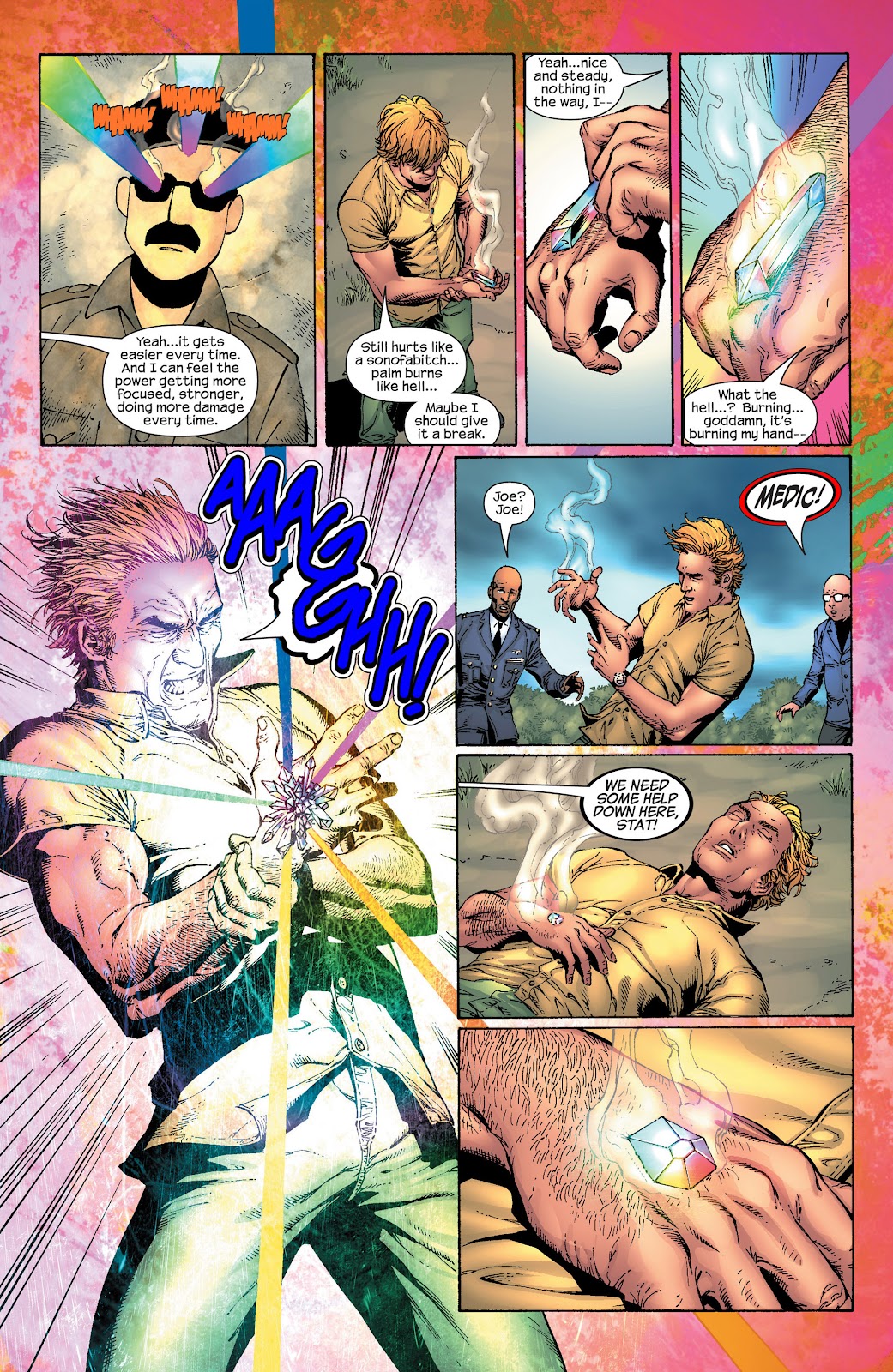 Somewhere in the Mediterranean (possibly the Aegean Sea), a woman and a small boy bring an offering of food to an old temple. There are depictions of naked female warriors in battle, on a wall and the boy says he heard a voice saying, "Something is stirring in the outside world." They depart and a hand comes out of a slit in the stone wall and takes the food. We cut back to Mark, who arrives at school. He can overhear the whispers and peer through walls to witness the conversations about how weird he seems and that people can tell he is not like them. He decides not to return and wonders if there are any others like him, anywhere else in the world, as we close with single panels of Joe Ledger, the orphaned young man, the empty food basket, and the child swimming under the ocean. 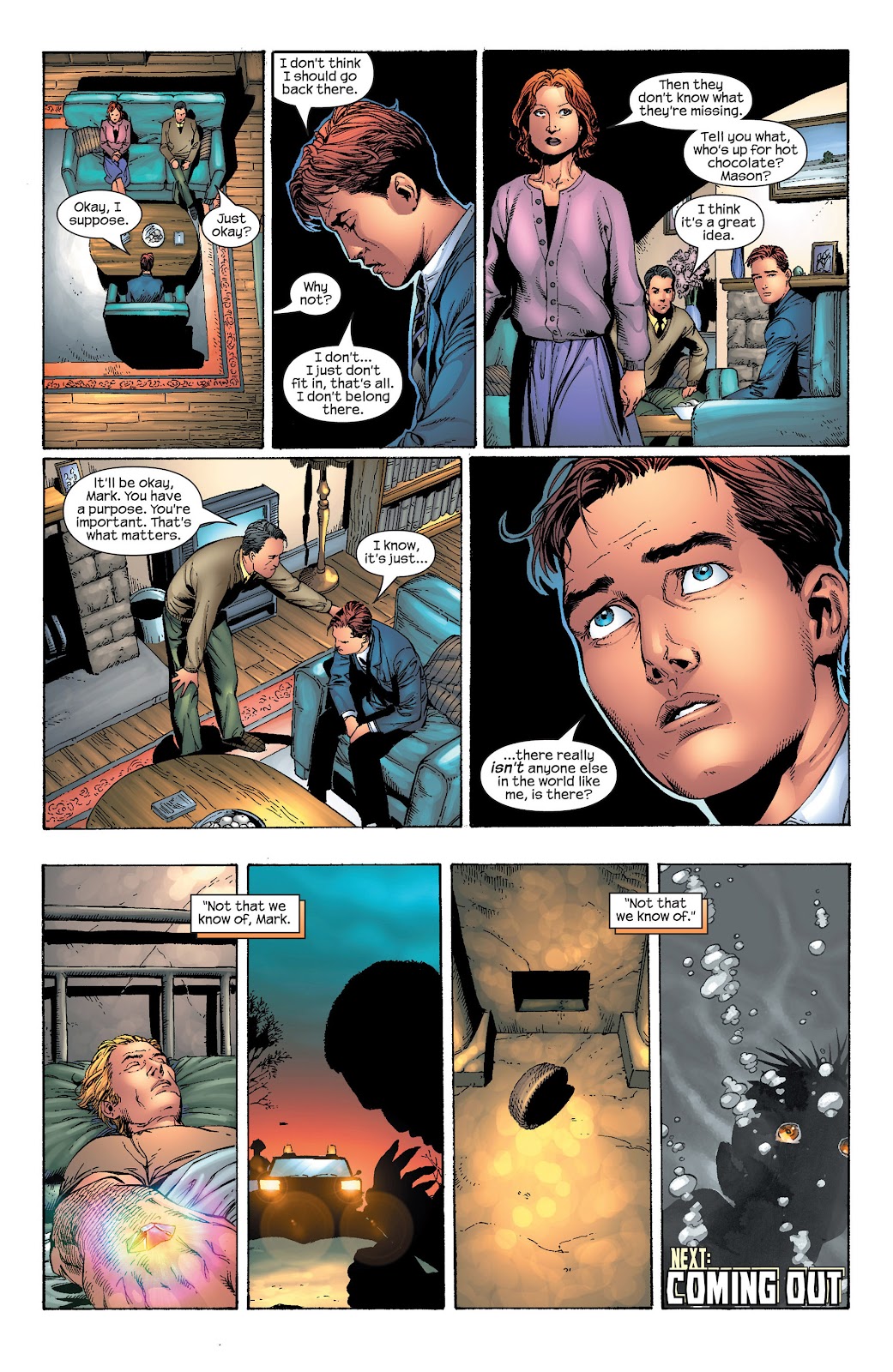 Thoughts: Thoughts: Mark Milton has entered his troubled adolescence. He wants to be with others and has learned to control his abilities. he wants to know where he belongs in the world and, like most adolescents, he tests the limits of his world. He presents the idea of going to school outside as a threat, as he questions whether his parents (and, thereby, the people watching) consider him dangerous. They send an armored vehicle to hide him and watch over; but, he demonstrates that armored plate poses no problems for him. We see others with special abilities, as we are introduced to the universe's Dr Spectrum, Power Princess, Nighthawk and Amphibian. Spectrum is a cold-blooded murderer, working for the government in Guatemala. The US government, at the behest of United Fruit Company, overthrew the democratically elected government of Jacobo Arbenz, in Guatemala, in 1954, establishing a puppet government, which it has propped up ever since. In the 1980s, there were reports of government death squads mascreing indian villages, in the hills and mountain regions, trained by the US at the School of the Americas, a training school for counter-insurgency, interrogation and torture. Joe Ledger appears to be a CIA paramilitary operative, working in that region. He is likened to a surgeon and is tasked to use his focused mind to test the crystal, without stray thoughts to create accidents. the end result is a merging with the crystal, which powered Hyperion's ship. Amphibian is some kind of hybrid, bonded to the DNA of the fetus that Debbie carried in her womb, or mutated due to exposure from something that fell off of Hyperion's pod. We see at least two or three offshoots from the pod , as it flies over. The African-American youth sees his parents gunned down by racist murderers and gains a symbol for his vengeance, in a nighthawk. Some remnant of an ancient amazonian tribe still lives in a nearly forgotten temple and it senses something stirring in the world, appearing ready to re-emerge. Through it all, Mark learns that others fear him and can sense he isn't human, no matter what he looks like. Well, showing up in an APC isn't exactly the best way to start at a new school. JMS continues his world building, while demonstrating the isolation and alienation that Mark feels. He tests his boundaries. He can see and hear others and knows how different he is. he can probably see his watchers and hear them, and knows how they fear his potential power. No matter the conditioning, it can't change the feeling of being alone in the world and knowing that other fear you. What happens when Mark decides to test that fear? JMS is using Mark as a metaphor for most adolescence, as we test the limits of parental and school authority, try to find our place in the world, and wonder if anyone feels the same as we do. We all, at one time or another, feel alone in the world, that no one understands what we think and feel, though we eventually learn (hopefully) that we all go through this and are more alike than different. Joe Ledger is the dirty part of government security, a weapon used to carry out dirty missions. The 1950s and 60s were a time of the CIA running almost unchecked, as they overthrew governments in Guatemala and Iran, interfered in elections in Italy, aided dictators against rebels, and tried to invade Cuba. A series of scandals, in the wake of Vietnam, led to some housecleaning, during the Carter years; but, the Reagan Administration took the gloves off and there were reports of the CIA activity in Latin America (especially Nicaragua, El Salvador and Honduras) as well as the trumped up invasion of Grenada. Dirty tricks returned to the playbook and the School of the Americas was running at full steam, while nuns protested outside the fence (in relation to the murders of Catholic nuns in El Salvador, by government death squads, trained at the school). We see our Batman, in his new Nighthawk, an African-American whose parents are killed in a racially motivated murder. This is practically ripped from recent headlines; but, preceded them by nearly 15 years. This Batman has wealth; but, an even greater purpose and hatred, not just of crime and murder; but of bigots and racist thugs. Amphibian is born in pain and sorrow and is physically different, reflecting children born with such conditions as Down Syndrome, acromegaly, dwarfism, or other conditions that cause physical or mental abnormalities. The parents react as if the child is a monster. JMS repeats his cosmic event, from Rising Stars, that would bring superpowers where there had been none. Something came off Hyperion's pod; but, we won't learn exactly what, for a while. this also follows the genetic manipulation of races by the Vorlons, in Babylon 5, which was inspired by the Lensman Saga, by EE "Doc" Smith, with the Arisians and the Edorreans, who manipulate lesser races, in their battles against one another. Gary Frank continues his excellent work, though his image of a teenage girl, at Mark's school is a bit strange. It looks like she is based on an actress; but, I haven't been able to put my finger on it. She is shown with exceedingly wide eyes and lots of white teeth, like she has been stunned, while at the dentist. When first seen in the cafeteria, it looks like someone has just goosed her! So, we have met many of the future Squadron Supreme and seen how isolated Mark is. What happens next?
|
|
|
|
Post by mikelmidnight on Mar 16, 2019 12:22:33 GMT -5
I continued to enjoy this series, but a couple of comments here:
The Justice Brigade, the parents of the Inferior Five, who were modeled on the Justice League, also had a female Aquaman counterpart (named Mermaid). I don't believe that was an influence, just saying there's precedent!
The idea of a divergence from the real world springing from a crashed alien spaceship can also be seen in Alan Moore's Marvelman.
How come the two female characters in the group (Amphibian and Power Princess) are the only ones who spend so much time naked?
|
|
|
|
Post by rberman on Mar 16, 2019 17:02:00 GMT -5
Supreme Power #2
My Two Cents: By the end of this issue, our “Super” count is up to six (counting Nighthawk), but the story still firmly belongs to Mark Milton. Much could be said about the government not doing a good job raising Mark Milton, who metaphorically is standing in for all the children of America. Point granted, but look at the options. The story of kindly Ma and Pa Kent is quite rose-colored, especially if the child manifested Superbaby powers and was essentially impervious to discipline. Dr. Spock’s theory that children should have only positive reinforcement would get quite a field test. Mark’s teen years are pretty benign all things considered; his “parents’” attempt to instill morality in him appears to have been quite successful. Yesterday I mentioned a few stories to which Supreme Power could be compared. Another significant one is Mark Millar’s Superman: Red Son (2003), an Elseworlds which imagines Superman being raised by Soviet farmers and instilled with a collectivist mentality. Convinced of the rightness of communism, he ascends to the Supreme Soviet, using his powers to micromanage every aspect of society as the benign, all-wise Platonic philosopher king. His nonstop efforts yield results but also breed dissent; he has no qualms about brainwashing dissenters into android “Superman Robots.” He eventually realizes that he is stifling human development and must step aside.     I suppose we are to understand that the baby born to the suicidal mama was genetically unstable, transforming into a mer-baby because of exposure to the ocean. Otherwise it’s too great a coincidence that such a baby just happened to be born right beside the ocean. More on her (spoiler: female) in future issues.  The Batman-style origin for Nighthawk was well played, from the explanation of the name to the appearance of the titular bird in the final panel. Kyle Richmond’s dad… is he really a “rich man”? He just now has enough money to move out of Memphis. That doesn’t sound like a billionaire to me. Maybe he’s being modest. They certainly aren’t in Memphis in this scene, set at a country church marauded by racist rednecks. Perhaps it's just an example of myopic LA/NYC types not knowing that Memphis is a metropolis of a million people? The same foolishness was on display in the original cut of Iron Man 3, which portrayed Chattanooga as a one stoplight town instead of a major city with superfast internet access.  I too found this one frame of the schoolgirl to be oddly plastic. Her eyes are strangely wide, turning her smile into more of a hideous rictus. Not Gray Frank’s best moment. I wonder what happened to the school after Milton declared he didn’t want to keep going. Did he continue anyway? Did it continue without him? Doesn’t matter for our story, but still.  I have a different take on Joe Ledger than codystarbuck does. I don’t see evidence of him being a “coldblooded murderer,” though I will grant at least “hardbitten soldier.” He’s not shown murdering babies or anything. He’s a faithful government agent but not a sadist, neither as noble as Captain America nor as obnoxious as USAgent. Already these characters have distinct personalities and agendas, and we're only two issues into the series. 
|
|
|
|
Post by codystarbuck on Mar 17, 2019 0:46:18 GMT -5
This is the scene as Ledger is taken from Guatemala.... 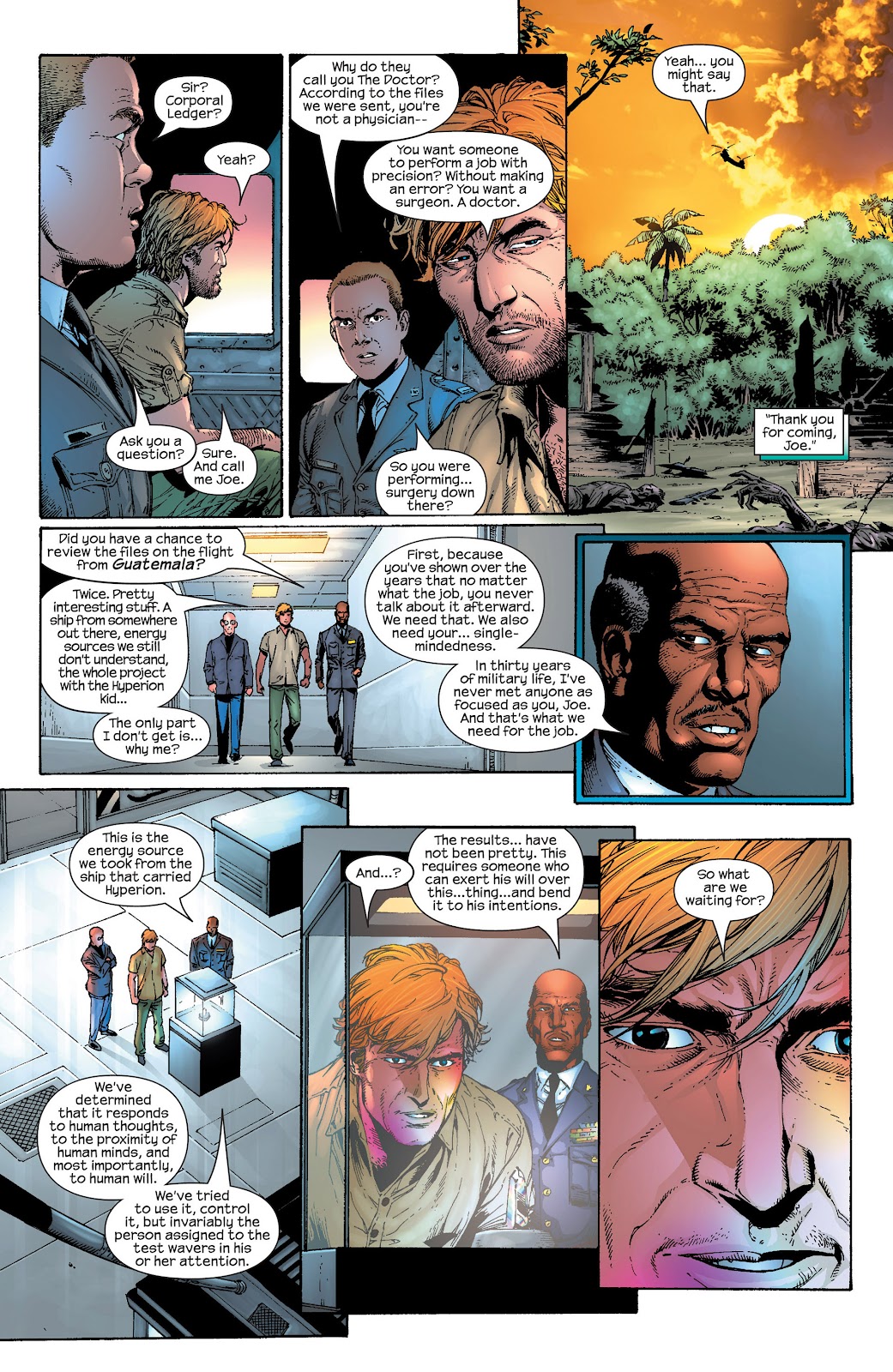 I stand by cold-blooded murderer. The dialogue juxtaposed to the bodies, the deliberate mention of Guatemala; that is not the work of a soldier. That is political murder. We had a rather low opinion of "spooks" in the military, whether CIA, ONI types or paramilitary operatives working for them. Even spec ops types weren't fond of that type of mission and many felt it perverted what they had been established to do. I also think JMS is making a deliberate connection to the death squads and the "advisors" who worked with them, by establishing it as Guatemala. Only El Salvador (maybe Nicaragua) would have been more on the nose, mainly because Guatemala's atrocities went under-reported, by US news agencies. Regardless, this Joe Ledger is a far cry from the astronaut who was presented the power prism by the Skrull, Skymax. As far as Amphibian, we will later see that whatever it is that was jettisoned from the pob has a mutating effect. I suspect the stage the child was in made it adaptable to its environment; hence, the aquatic survival. Now, whether that was due to proximity to the ocean, from the start or due to the direct exposure, right after birth is up in the air. The child was definitely not human-looking, at birth, which is a parallel to the second V mini-series, where the human teenager has twins, father by one of the Visitors; one human, one reptilian, which dies soon after birth, as it can't adapt to the environment. In regards the teenage girl in Mark's school, I get the sense that he was trying to work from a model and wasn't able to get the look down, for whatever reason. The look seems very familiar, though. There is a certain Faye Dunaway quality to it; but, I am thinking someone from a younger Hollywood generation. It just kind of nags at my brain. Richmond has his own business, that is taking him to New York. It's left up to interpretation how successful it is. It could be that Kyle is the one who turns it into a multi-million dollar (or billion) conglomerate. The father does talk about the business doing well enough to leave Memphis. JMS is not one to mistake memphis for a small town. I think he refers more to Memphis for its racial history, particularly the murder of Dr Martin Luther King Jr. It can be interpreted as Titus Richmond feeling that he has left that world behind, for a better tomorrow, making his death all the more tragic. |
|
|
|
Post by codystarbuck on Mar 17, 2019 1:47:02 GMT -5
Supreme Power #3 Creative Team: Creative Team: Same bunch. Synopsis: We open with Mark, at the White House, waiting, while Gen Casey briefs Pres. Bush (Sr). They talk about his abilities and whther he is ready to be a force for the country. They talk about the obvious, then bush asks about hearing, which the general admits hasn't really been tested and Bush immediately keys in that he can probably hear them and says to get him in. he then puts the case to mark, to serve his country and he agrees. he is sent to Operation: Desert Storm, to go into the Iraqi lines, in advance of the ground assault, to take out key resources; but, in secret. We see him head out, then see the reactions of soldiers observing from their positions and the implication is that it is nasty. 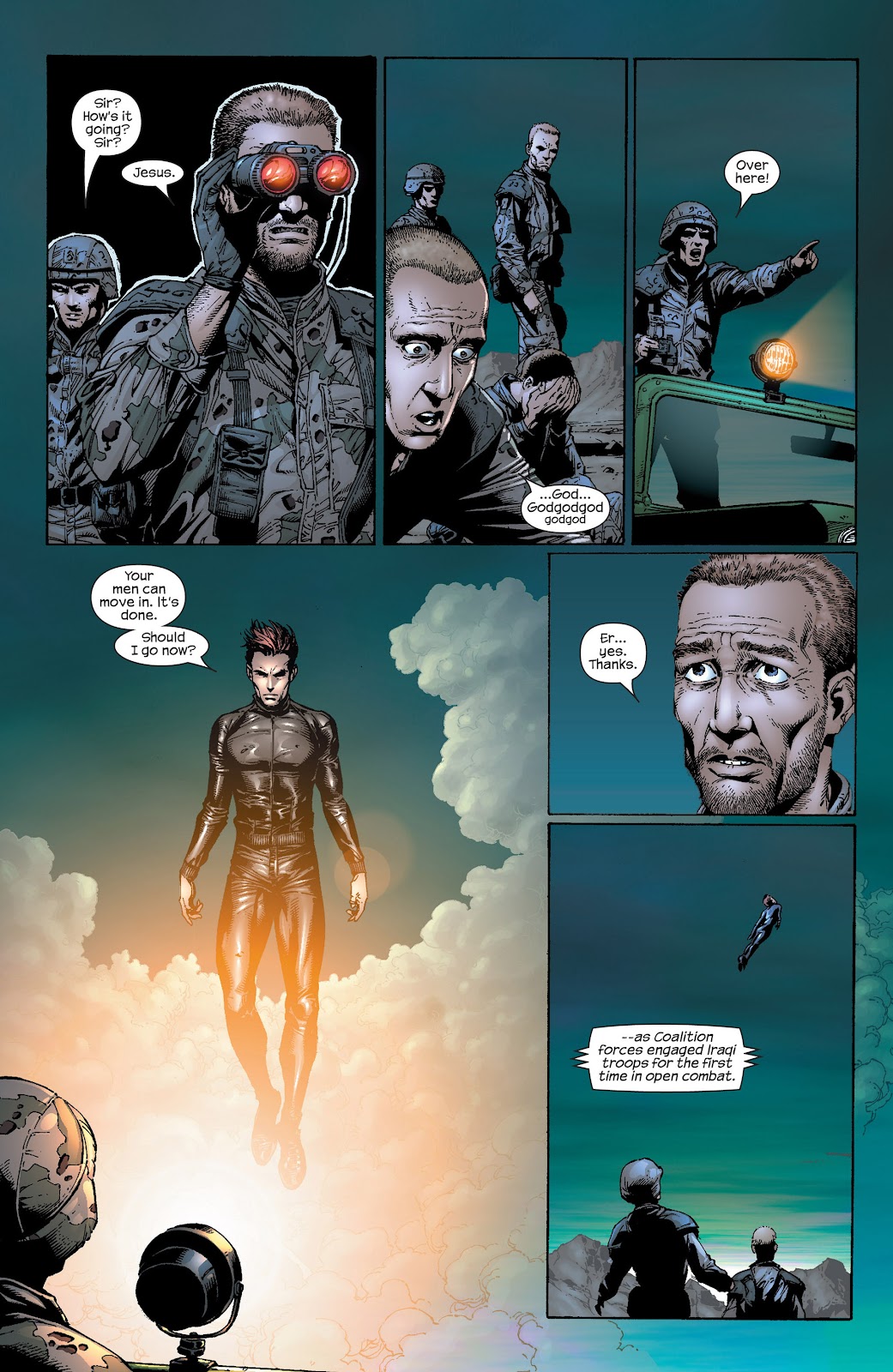 This segues into journalist Jason Scott, who analyzes reports of the assault and talk of precision weapons taking out Iraqi strongpoints, leaving little resistance when the ground assault occurs. Over time, he notices other odd events, where journalists were kept away; but, miraculous accomplishments are carried out, without anyone in the military taking credit for them, as a bystander. His editor thinks he is chasing ghosts and we see him talk to a parade of conspiracy theorists and assorted loonies; but, there are a few nuggets in there... 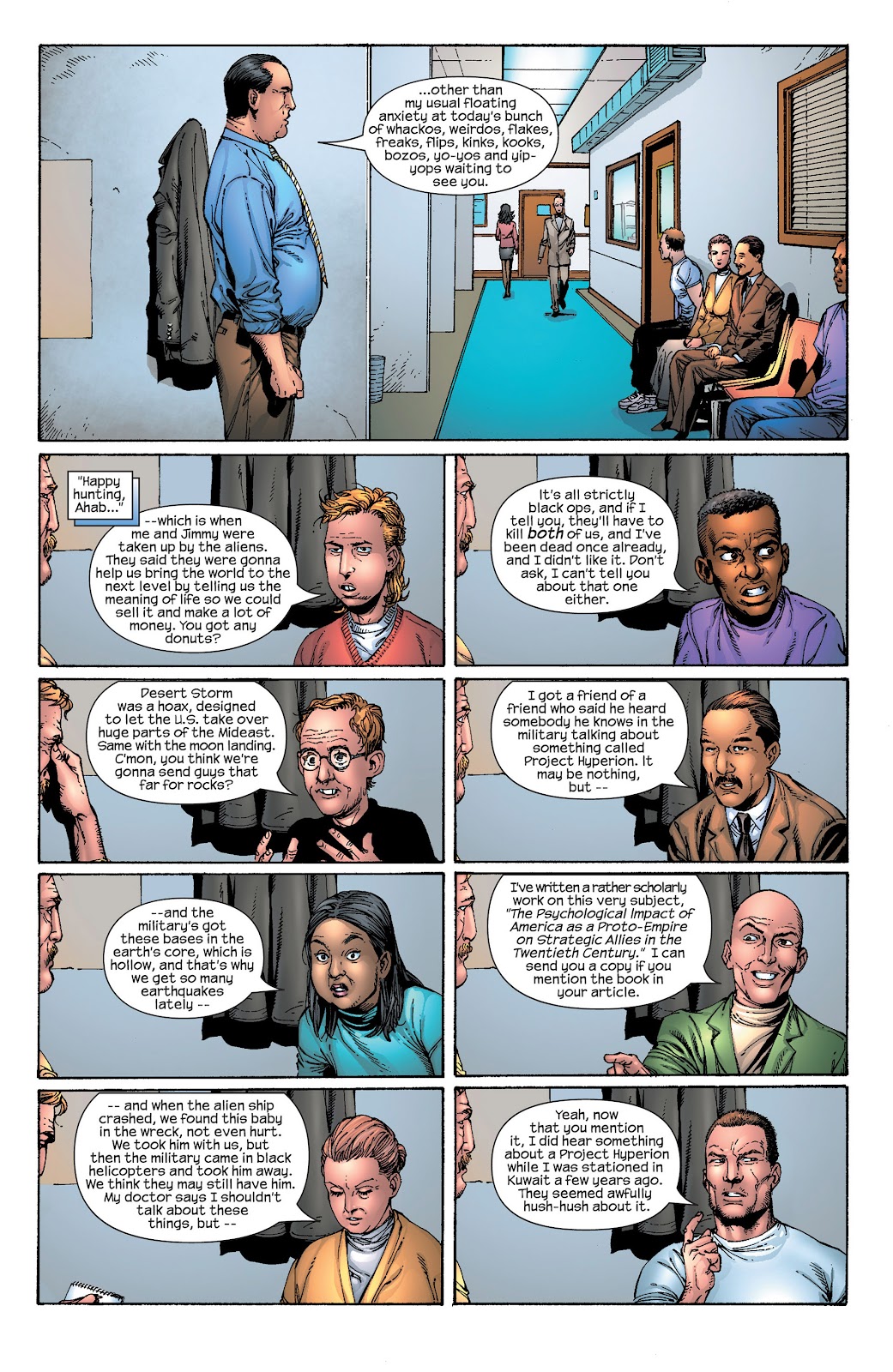 He makes a Freedom of Information request, related to project: Hyperion, and gets a massively redacted file. He meets with a government contact, who is more skittish than usual, and warns him he is being followed. the man gives him the lowdown, with the warning that he will kill Scott is his name turns up in any way connected to the story. the truth scares Jason. he meets again with Mrs Cavanaugh, the woman who spoke of finding a child in a metal craft. He is remotely observed and we see a briefing of Pres. Clinton, relating to the story and others who are sniffing around. They decide to manage the release of the story and Jason Scott gets the scoop of a generation... 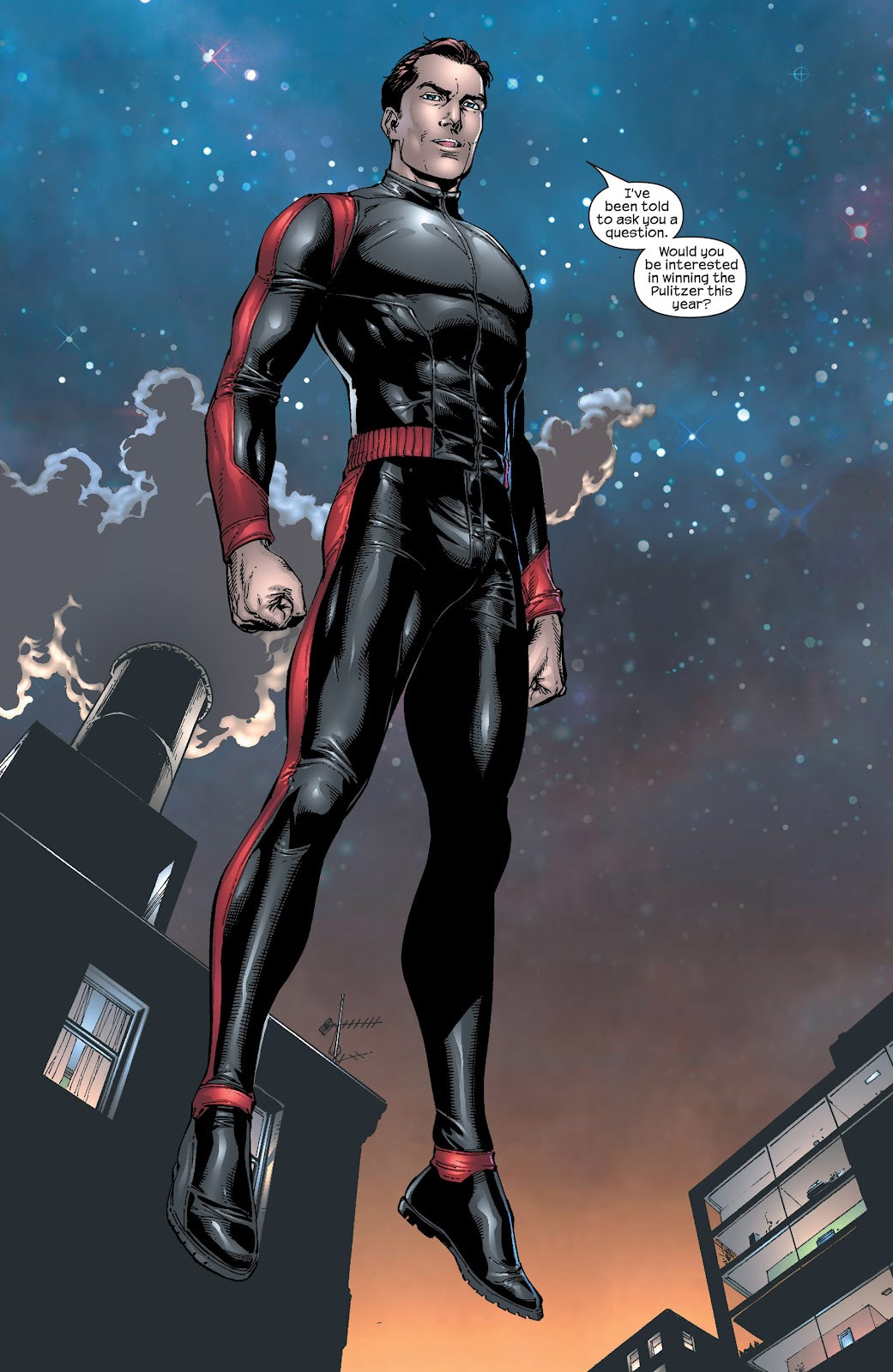 The story is released and the media is filled with talking heads, protests from China, and skeptical pundits. Our frozen faced teen is trotted out to talk about Mark, in school, doing a 180 on how she really reacted to him. We see further White House briefings about the upcoming press conference, political opposition from the Republicans, after they kept things secret, debate over his uniform; and, then, the actual unveiling at a White House press conference, where Mark appears in a sweater and tie. We then see Jason Scott not celebrating his scoop, as he knows he has been stage managed and lobbed softball questions to Mark, feeling sympathy for him. he did notice that he was alone and sad and that he doesn't see humanity the same is they do. he later asks Mark where he is really from and he doesn't know. Jason talks to his editor about sightings of a blurred figure, near Atlanta, when Mark was in front of reporters, at the White House. What if Mark isn't the only powerful being on the planet? Thoughts: JMS now brings Hyperion to public eyes, after first demonstrating the more sinister use of his powers, as he is responsible for softening up the Iraqi's, in advance of the ground assault. I served at a destroyer squadron during the war and what JMS describes isn't far from some of what went on. The media were stage managed and fed gun camera footage and constant talk of precision weapons and lapped it up, until peter Arnett unveiled footage of "collateral damage," in Iraqi neighborhoods. There was more that wasn't seen on CNN. Desert Storm was used as an excuse for weapons testing across the board and the US Navy launched nearly its entire stock of Tomahawk missiles, since they never had a testing opportunity like that. of course, those stockpiles had to be rebuilt, leading to massive resupply contracts. During the Gulf War, the US used the BLU-82B, better know as the Daisy Cutter, dropping approx. 11 on Iraqi positions. The bomb was developed during the Vietnam War to create instant landing zones in the jungle, as it creates a massive shockwave, around 1000 lbs per square inch, which obliterates everything in its path. The bomb weighs 15,000 lbs and is dropped out of a cargo transport. It had been reserved as a psy-war weapon, post Vietnam, and the shockwave is very similar to a nuclear explosion. The rumor we heard was that, after using one, our allies contacted us and asked us if we just nuked Iraq; or, even worse, if the Israelis had, in response to SCUD attacks. The bombs didn't get much attention until after the war, as journalists were treated like mushrooms (kept in the dark, fed only s@#%). The bombs were again used in Afghanistan. These weapons were used to demoralize Iraqi soldiers and leaflets were dropped in advance of their use. Iraqis did surrender in droves, though much of that was due to the Revolutionary Guard being withdrawn from frontline positions, replaced by conscripts and lesser units. However, the media was all over reports of mass surrenders and pictures of burning armored vehicles in the desert. JMS draws parallels between Hyperion and these weapons, showing that in the government's hands, Mark Milton is the ultimate weapon of mass destruction. He's a thinking one. Jason Scott talks about the haunted, distant look in his eyes, as we see scenes of his indoctrination and his senses revealing the truth and withholding information from scientists, so they don't know his full power. The implication is that he is playing along, as long as it suits his purpose. He is a dragon on a chain; but, can the wizard really control the dragon or is the dragon just humoring him, until he is ready to devour the wizard? Jason Scott parallels Woodward and Bernstein (who are name-checked) as he pursues the rumors of a human weapon, in Kuwait. He wades through a sea of conspiracy nuts and attention seekers; but, runs across a few nuggets that lead him to veins of information. We see the return of part of the kindly couple, from Mark's Earth landing, We see a government type mentioning Project: Hyperion, and a soldier who speaks of rumors in Kuwait. That leads Scott past the moon landing hoaxers and alien abductees, to sources with real info, who keep nervously checking the sky. We also get a sense that Mark is changing history. Jason's story board, with mysterious events, includes a rescue in Mogadishu, rather than the debacle of Blackhawk Down. The LA Riots are "stopped by the National Guard." An arms crisis in North Korea is diffused. The world is changing. The unveiling is stage managed, both for political gain, by Pres. Clinton, and to control the story. Scott is a celebrity; but, recognizes that he has been manipulated and then unveils the potential bigger story, that there are others that may be unknown, even to the government. Lots of talking heads, this issue; but, Gary Frank handles it well, using similar techniques to Frank Miller and Howard Chaykin, from 20 years before, in Dark Knight and American Flagg (though similar media reports have been used since the dawn of comics). This one is all Mark, until the very end, with talk of the Atlanta Blur. Our next issue will include Mark's first meeting with someone who may be like him, and we will see someone who is definitely not like him, entirely.
|
|
|
|
Post by rberman on Mar 17, 2019 7:22:21 GMT -5
Richmond has his own business, that is taking him to New York. It's left up to interpretation how successful it is. It could be that Kyle is the one who turns it into a multi-million dollar (or billion) conglomerate. The father does talk about the business doing well enough to leave Memphis. JMS is not one to mistake memphis for a small town. I think he refers more to Memphis for its racial history, particularly the murder of Dr Martin Luther King Jr. It can be interpreted as Titus Richmond feeling that he has left that world behind, for a better tomorrow, making his death all the more tragic. There's some dialogue about Richmond having come into his inheritance, so evidently much of his money came from dad. |
|
|
|
Post by rberman on Mar 17, 2019 7:41:09 GMT -5
Supreme Power #3
My Two Cents: This issue belongs to Jason Scott, the dogged reporter whose work forces the military to admit the existence of Hyperion. He’s efficiently characterized, a smart curmudgeon who knows in his gut that even the revelation of Hyperion is a distraction from deeper secrets.  JMS pulls a page from Alan Moore’s gamebook, juxtaposing a captioned monologue lauding Milton’s benign upbringing with flashback images which show the truth underneath Bill Clinton’s allegedly “open” words.  Superheroes also turned the tide of war in Watchmen, though Dr. Manhattan had value for propaganda as well as military action, since Vietnam was open warfare, whereas Mark Milton’s power lies in his covert work.  Grant Morrison’s graphic novel JLA: Earth-2 also featured superheroes flexing military muscle, though fretting about whether they were pursuing the correct course.  Mark Milton already knows the fix is in. Here we see him crying as he recalls how he stayed at home because his "parents" said they loved him. Not that he believes they really did love him. In that context, “I love you just as much as you love me” becomes quite a threat. This is good writing.  Incidentally: Mark Milton is a head taller than Bill Clinton, who is already tall at 6’2”. At 6’8” or so, Mark must cut quite the imposing figure. 
|
|